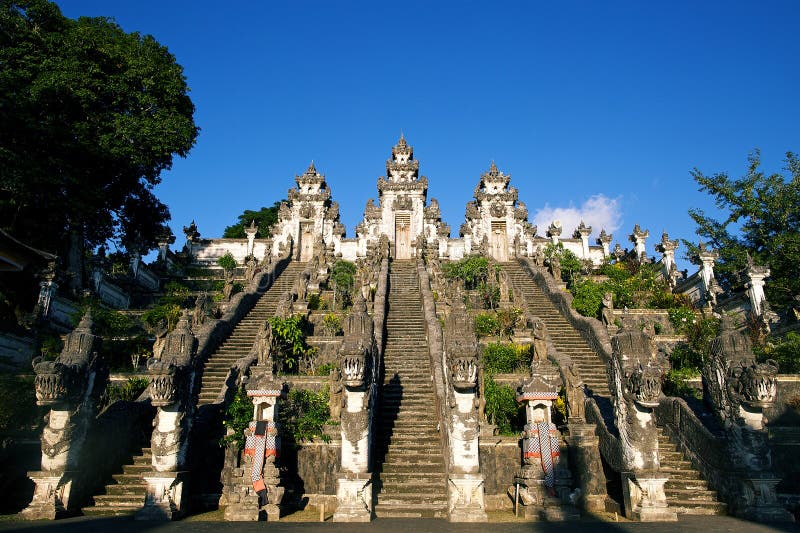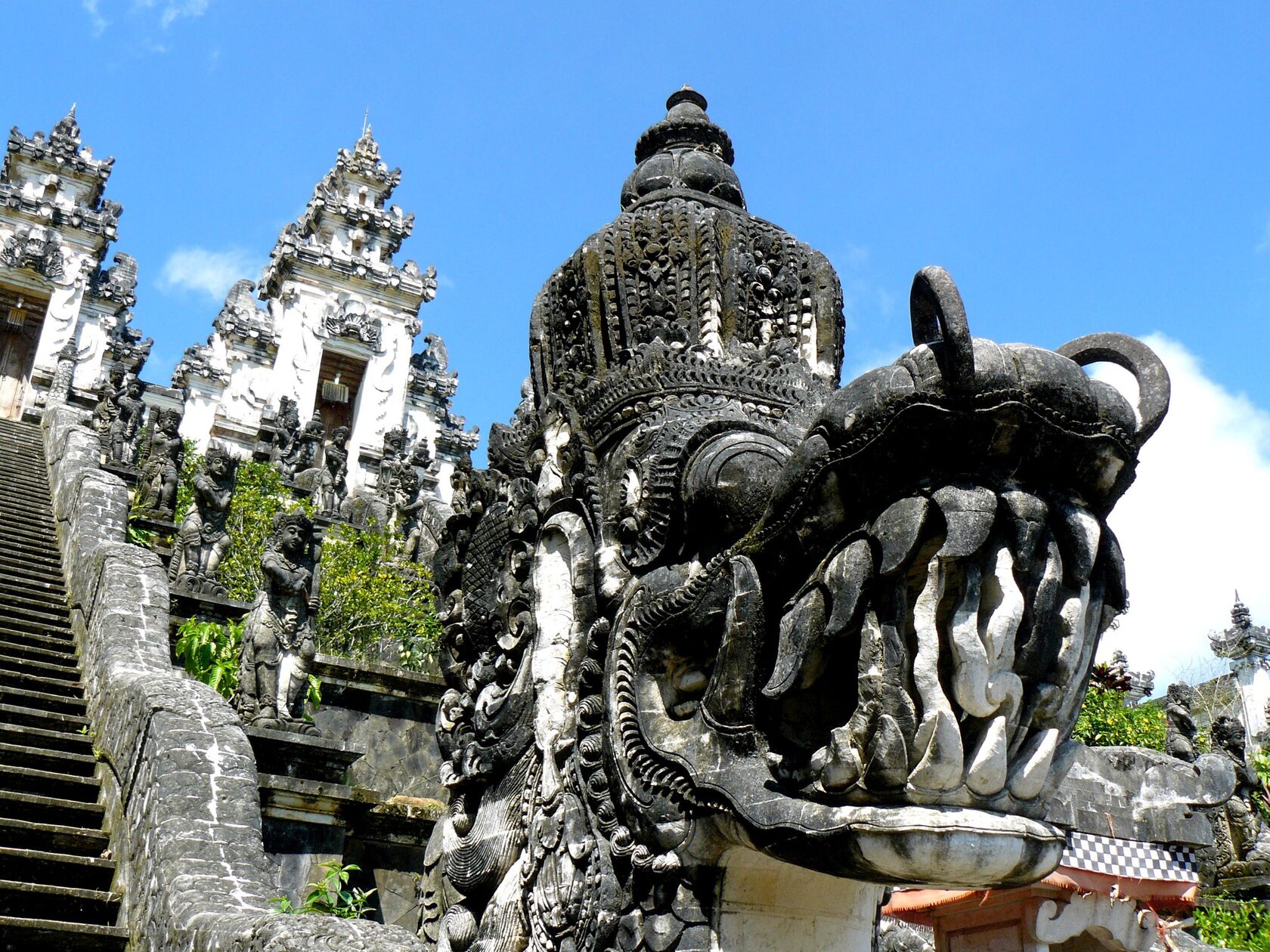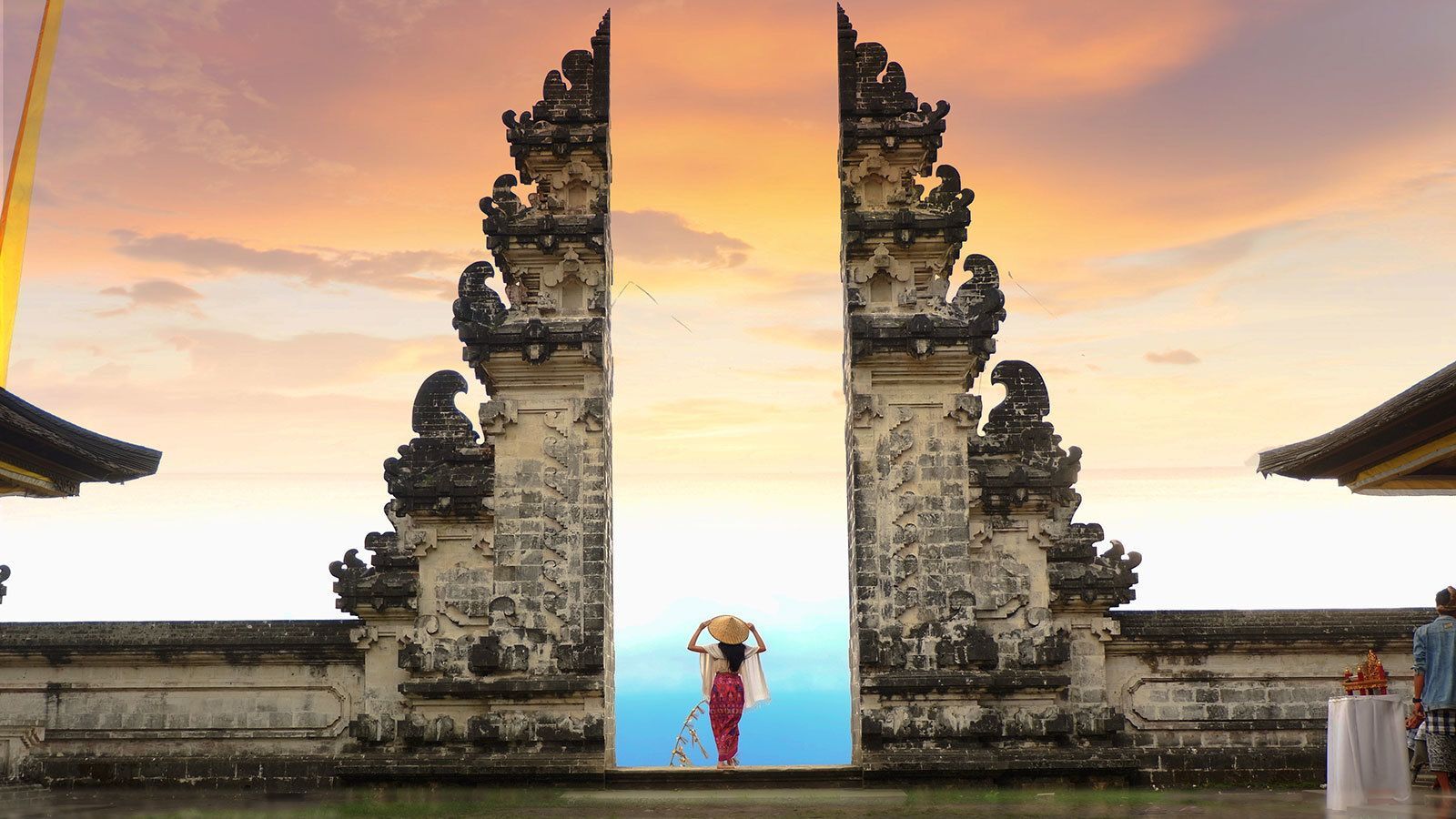Pura Lempuyang Temple
Pura Luhur Lempuyang, or Lempuyang Temple, is considered one of the oldest and most revered temples on the island of Bali. This temple is one of the island's nine main shrines, known as “Kayangan Jagat”, which are designed to maintain the spiritual balance of Bali.
Pura Luhur Lempuyang: A Sacred Complex in Eastern Bali
Pura Luhur Lempuyang is one of the oldest and most revered temples on Bali. It is located on the eastern side of the island, perched atop the mountain of the same name near the Agung volcano. The temple complex comprises seven temples, with the main sanctuary set at an altitude of 1,058 meters above sea level, accessed by climbing more than 1,500 steps.
History of the Temple
According to legend, this sacred site existed here as far back as 2,000 years ago, long before the arrival of Hinduism. Written sources suggest the temple was founded in the 11th century, with the earliest known reference dating back to 1072. During this period, other mountain temples were also being built. It was believed that Bali’s peaks came from the sacred Mount Meru, which had split. Legend states that the god Pasupati sent three of his children to the island’s highest points to establish balance, leading to the construction of temples on Mount Batur, Mount Agung, and Mount Lempuyang.
Until the mid-20th century, Lempuyang Temple was neglected. Overgrown by dense forest, many of its stone structures had partially deteriorated. Restoration efforts began in the 1960s, giving rise to the modern buildings that stand today. Despite these updates, the temples retain their sanctity and grandeur.
Structure of the Complex
The temple complex is made up of seven shrines connected by stone staircases and jungle paths.
• Lower section of the mountain: Dedicated to the god Brahma.
• Middle section: Dedicated to the god Vishnu.
• Upper section: Dedicated to the god Shiva.
The temples include:
1. Pura Penataran Agung Lempuyang – the most famous temple, where the ascent begins, known for its “Gates of Heaven.”
2. Pura Telaga Mas
3. Pura Telaga Sawangan
4. Pura Lempuyang Madya
5. Pura Pucak Bisbis
6. Pura Pasar Agung
7. Pura Lempuyang Luhur – the main temple at the summit
Routes to the Main Sanctuary
Travelers can reach the principal temple via several paths:
• Short route: A direct walk to the main sanctuary takes about 2–3 hours.
• Long route: Passing through all seven temples can take 4–6 hours, depending on fitness and rest stops.
There are also a few turnoffs where one can shorten the route if needed.
Significance and Rituals
The Lempuyang temples are part of Balinese Hindu tradition, and the climb symbolizes purification of body and soul. Visitors must:
• Wear a sarong, available for rent at the entrance
• Respect the sacredness of the site by avoiding loud noises and inappropriate behavior
Tips for Tourists
1. Visit early in the morning to avoid heat and catch the sunrise.
2. Prepare for a strenuous climb with adequate fitness.
3. Bring water and snacks for the journey.
4. Don’t miss a photo at the famous “Gates of Heaven,” a popular spot offering stunning views of Mount Agung.
Why Visit
• Spiritual significance: Lempuyang is considered one of the key temples maintaining Bali’s balance.
• Breathtaking views: Panoramic vistas of Mount Agung, the jungle, and the ocean reward those who reach the summit.
• Cultural immersion: Exploring the temple offers deeper insight into ancient Balinese Hindu traditions.
Pura Luhur Lempuyang is a place where nature, history, and spirituality converge. Visiting this temple provides not only a physical challenge but also a profound cultural experience.
Pura Luhur Lempuyang is one of the oldest and most revered temples on Bali. It is located on the eastern side of the island, perched atop the mountain of the same name near the Agung volcano. The temple complex comprises seven temples, with the main sanctuary set at an altitude of 1,058 meters above sea level, accessed by climbing more than 1,500 steps.
History of the Temple
According to legend, this sacred site existed here as far back as 2,000 years ago, long before the arrival of Hinduism. Written sources suggest the temple was founded in the 11th century, with the earliest known reference dating back to 1072. During this period, other mountain temples were also being built. It was believed that Bali’s peaks came from the sacred Mount Meru, which had split. Legend states that the god Pasupati sent three of his children to the island’s highest points to establish balance, leading to the construction of temples on Mount Batur, Mount Agung, and Mount Lempuyang.
Until the mid-20th century, Lempuyang Temple was neglected. Overgrown by dense forest, many of its stone structures had partially deteriorated. Restoration efforts began in the 1960s, giving rise to the modern buildings that stand today. Despite these updates, the temples retain their sanctity and grandeur.
Structure of the Complex
The temple complex is made up of seven shrines connected by stone staircases and jungle paths.
• Lower section of the mountain: Dedicated to the god Brahma.
• Middle section: Dedicated to the god Vishnu.
• Upper section: Dedicated to the god Shiva.
The temples include:
1. Pura Penataran Agung Lempuyang – the most famous temple, where the ascent begins, known for its “Gates of Heaven.”
2. Pura Telaga Mas
3. Pura Telaga Sawangan
4. Pura Lempuyang Madya
5. Pura Pucak Bisbis
6. Pura Pasar Agung
7. Pura Lempuyang Luhur – the main temple at the summit
Routes to the Main Sanctuary
Travelers can reach the principal temple via several paths:
• Short route: A direct walk to the main sanctuary takes about 2–3 hours.
• Long route: Passing through all seven temples can take 4–6 hours, depending on fitness and rest stops.
There are also a few turnoffs where one can shorten the route if needed.
Significance and Rituals
The Lempuyang temples are part of Balinese Hindu tradition, and the climb symbolizes purification of body and soul. Visitors must:
• Wear a sarong, available for rent at the entrance
• Respect the sacredness of the site by avoiding loud noises and inappropriate behavior
Tips for Tourists
1. Visit early in the morning to avoid heat and catch the sunrise.
2. Prepare for a strenuous climb with adequate fitness.
3. Bring water and snacks for the journey.
4. Don’t miss a photo at the famous “Gates of Heaven,” a popular spot offering stunning views of Mount Agung.
Why Visit
• Spiritual significance: Lempuyang is considered one of the key temples maintaining Bali’s balance.
• Breathtaking views: Panoramic vistas of Mount Agung, the jungle, and the ocean reward those who reach the summit.
• Cultural immersion: Exploring the temple offers deeper insight into ancient Balinese Hindu traditions.
Pura Luhur Lempuyang is a place where nature, history, and spirituality converge. Visiting this temple provides not only a physical challenge but also a profound cultural experience.

Full Name of the Temple
The complete name of the Lempuyang Temple is Pura Sad Kahyangan Lempuyang Luhur. Its name carries deep symbolic meaning. One of the most well-known interpretations is “Heavenly Vertigo,” where Luhur means “heavenly” and Lempuyang translates as “vertigo.” However, the official 1998 publication of the Bali Cultural Office offers a different explanation: Lampu means “radiance,” and Hyang refers to “the deified spirit of ancestors.” Thus, the overall meaning is “the radiant light of God that shines brilliantly on everything.”
Temple Dedication
The temple is dedicated to Ishvara (Dewa Iswara), the One God who, in Hindu philosophy, is considered the Creator of the Universe. He is also known as Sang Hyang Widi Wasa, which can be translated as “the Almighty God.” Ishvara is often portrayed as a nude figure surrounded by flames, symbolizing creative energy.
In Balinese temples, Ishvara is represented through Padmasana—lotus thrones that stand for purity and harmony.
Distinctive Features of Balinese Hinduism
Balinese religious tradition, known as Agama Hindu Dharma, is a synthesis of Hinduism, Buddhism, and ancient local beliefs. It differs from classical Indian Hinduism through its emphasis on a monotheistic concept and local interpretations of philosophical ideas.
Main tenets of Balinese Hinduism:
1. One God: There is only one supreme God from whom the entire world originated.
2. Trimurti: The concept of three principal deities—Brahma (the Creator), Vishnu (the Preserver), and Shiva (the Destroyer). They are manifestations of the One God, maintaining balance and governing the cycle of life, birth, and death.
3. Atma (the Soul): The universal principle of life and consciousness. The soul is immortal and transmigrates into new bodies through reincarnation.
4. Karma: The sum of a person’s actions that determine subsequent lives.
5. Samsara: The endless cycle of birth, life, and death.
6. Moksha: Liberation from samsara and the attainment of oneness with God.
Hinduism and State Policy
After Indonesia gained independence in the mid-20th century, the government adopted a policy of religious freedom but required all recognized faiths to be monotheistic. This prompted Balinese Hinduism to focus more on the idea of a single God. The formal emphasis on Ishvara as the One God ensured that Balinese Hinduism conformed to this requirement.
Conclusion
Pura Sad Kahyangan Lempuyang Luhur is not only a place of worship but also a symbol of the profound philosophy underlying Balinese Hinduism. Its name and dedication to Ishvara underscore the unique monotheistic interpretation within the local religious tradition. This temple serves as a reminder of the harmony among humans, nature, and the higher powers—forces that are inextricably linked in Balinese culture.
The complete name of the Lempuyang Temple is Pura Sad Kahyangan Lempuyang Luhur. Its name carries deep symbolic meaning. One of the most well-known interpretations is “Heavenly Vertigo,” where Luhur means “heavenly” and Lempuyang translates as “vertigo.” However, the official 1998 publication of the Bali Cultural Office offers a different explanation: Lampu means “radiance,” and Hyang refers to “the deified spirit of ancestors.” Thus, the overall meaning is “the radiant light of God that shines brilliantly on everything.”
Temple Dedication
The temple is dedicated to Ishvara (Dewa Iswara), the One God who, in Hindu philosophy, is considered the Creator of the Universe. He is also known as Sang Hyang Widi Wasa, which can be translated as “the Almighty God.” Ishvara is often portrayed as a nude figure surrounded by flames, symbolizing creative energy.
In Balinese temples, Ishvara is represented through Padmasana—lotus thrones that stand for purity and harmony.
Distinctive Features of Balinese Hinduism
Balinese religious tradition, known as Agama Hindu Dharma, is a synthesis of Hinduism, Buddhism, and ancient local beliefs. It differs from classical Indian Hinduism through its emphasis on a monotheistic concept and local interpretations of philosophical ideas.
Main tenets of Balinese Hinduism:
1. One God: There is only one supreme God from whom the entire world originated.
2. Trimurti: The concept of three principal deities—Brahma (the Creator), Vishnu (the Preserver), and Shiva (the Destroyer). They are manifestations of the One God, maintaining balance and governing the cycle of life, birth, and death.
3. Atma (the Soul): The universal principle of life and consciousness. The soul is immortal and transmigrates into new bodies through reincarnation.
4. Karma: The sum of a person’s actions that determine subsequent lives.
5. Samsara: The endless cycle of birth, life, and death.
6. Moksha: Liberation from samsara and the attainment of oneness with God.
Hinduism and State Policy
After Indonesia gained independence in the mid-20th century, the government adopted a policy of religious freedom but required all recognized faiths to be monotheistic. This prompted Balinese Hinduism to focus more on the idea of a single God. The formal emphasis on Ishvara as the One God ensured that Balinese Hinduism conformed to this requirement.
Conclusion
Pura Sad Kahyangan Lempuyang Luhur is not only a place of worship but also a symbol of the profound philosophy underlying Balinese Hinduism. Its name and dedication to Ishvara underscore the unique monotheistic interpretation within the local religious tradition. This temple serves as a reminder of the harmony among humans, nature, and the higher powers—forces that are inextricably linked in Balinese culture.

Pura Lempuyang Temple is located here
